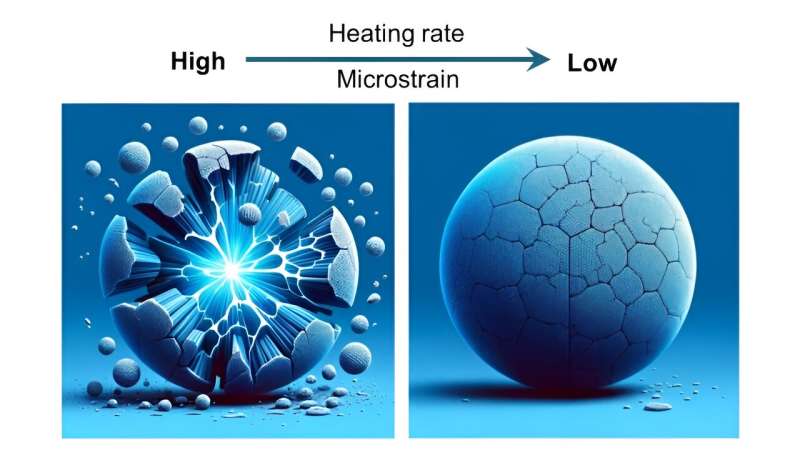
September 27, 2024 by Argonne National Laboratory
Collected at: https://phys.org/news/2024-09-key-problem-sodium-ion-batteries.html
Lithium-ion batteries have long dominated the market as the go-to power source for electric vehicles. They are also increasingly being considered for storage of renewable energy to be used on the electric grid. However, with the rapid expansion of this market, supply shortages of lithium are projected within the next five to 10 years.
“Sodium-ion batteries are emerging as a compelling alternative to lithium-ion batteries due to the greater abundance and lower cost of sodium,” said Gui-Liang Xu, a chemist at the U.S. Department of Energy’s (DOE) Argonne National Laboratory.
To date, there has been a serious roadblock to the commercialization of such batteries. In particular, the performance of the sodium-containing cathode rapidly declines with repeated discharge and charge.
A team at Argonne has made important strides in resolving this issue with a new design for a sodium-ion oxide cathode. It is closely based on an earlier Argonne design for a lithium-ion oxide cathode with proven high energy storage capacity and long life. The research is published in the journal Nature Nanotechnology.
A key feature of both designs is that the microscopic cathode particles contain a mix of transition metals, which could include nickel, cobalt, iron or manganese. Importantly, these metals are not uniformly distributed in individual cathode particles. As an example, nickel appears at the core; surrounding this core are cobalt and manganese, which form a shell.
These elements serve different purposes. The manganese-rich surface gives the particle its structural stability during charge-discharge cycling. The nickel-rich core provides high capacity for energy storage.
In testing this design, however, the cathode’s energy storage capacity steadily declined during cycling. The problem was traced to the formation of cracks in the particles during cycling. These cracks formed due to strain arising between the shell and core in the particles. The team sought to eliminate that strain before cycling by fine-tuning their method of cathode preparation.
The precursor material used to start the synthesis process is a hydroxide. In addition to oxygen and hydrogen, it contains three metals: nickel, cobalt and manganese. The team made two versions of this hydroxide: One with the metals distributed in a gradient from core to shell and, for comparison, another with the three metals evenly distributed throughout each particle.
To form the final product, the team heated up a mixture of a precursor material and sodium hydroxide to as high as 600°C, maintained it at that temperature for a select period, then cooled it to room temperature. They also tried different heat-up rates.
During this entire treatment, the team monitored the structural changes in the particle properties. This analysis involved use of two DOE Office of Science user facilities: the Advanced Photon Source (beamlines 17-BM and 11-ID) at Argonne and the National Synchrotron Light Source II (beamline 18-ID) at DOE’s Brookhaven National Laboratory.
“With the X-ray beams at these facilities, we could determine real-time changes in the particle composition and structure under realistic synthesis conditions,” said Argonne beamline scientist Wenqian Xu.
The team also used the Center for Nanoscale Materials (CNM) at Argonne for additional analysis to characterize the particles and the Polaris supercomputer at the Argonne Leadership Computing Facility (ALCF) to reconstruct the X-ray data into detailed 3D images. The CNM and ALCF are also DOE Office of Science user facilities.
The initial results revealed no cracks in the uniform particles, but cracks forming in the gradient particles at temperatures as low as 250°C. These cracks appeared at the core and the core-shell boundary and then moved to the surface. Clearly, the metal gradient caused significant strain leading to these cracks.
“Since we know that gradient particles can produce cathodes with high energy storage capacity, we wanted to find heat treatment conditions that will eliminate the cracks in the gradient particles,” said Wenhua Zuo, an Argonne postdoctoral appointee.
The heat-up rate proved a critical factor. Cracks formed at a heat-up rate of five degrees per minute, but not at a slower rate of one degree per minute. Tests in small cells with cathode particles prepared at the slower rate maintained their high performance for more than 400 cycles.
“Preventing cracks during cathode synthesis pays big dividends when the cathode is later charged and discharged,” said Gui-Liang Xu. “And while sodium-ion batteries do not yet have sufficient energy density to power vehicles over long distances, they are ideal for urban driving.”
The team is now working to eliminate the nickel from the cathode, which would reduce the cost even further and be more sustainable.
“The prospects seem very good for future sodium-ion batteries with not only low cost and long life, but also energy density comparable to that of the lithium iron phosphate cathode now in many lithium-ion batteries,” said Khalil Amine, an Argonne Distinguished Fellow. “This would result in more sustainable electric vehicles with good driving range.”
More information: Wenhua Zuo et al, Microstrain screening towards defect-less layered transition metal oxide cathodes, Nature Nanotechnology (2024). DOI: 10.1038/s41565-024-01734-x
Journal information: Nature Nanotechnology

Leave a Reply